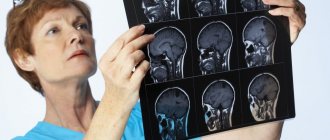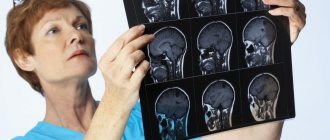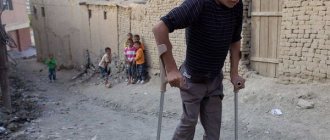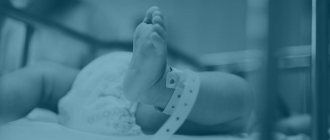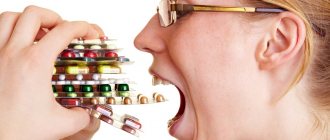This disorder is very common, affecting (to varying degrees of severity) 5% of the world's population. It usually accompanies OCD, neurosis, psychasthenia, and is present in half of patients with mental and neurological diseases. As for the “age qualification”, these are people from 25 to 45 years old, most of whom are women.
Treatment of anxiety-phobic disorders in Samara
Anxiety-phobic disorder (other names - obsessive-phobic disorder, obsessional neurosis, obsessive-phobic neurosis) is a neurotic disorder that causes phobias, obsessive (obsessive) states, sudden fears and thoughts. Obsessive states torment the patient, but he cannot get rid of them without outside help.
Causes of hysteroid disorder
Often, psychologists and psychiatrists try to find other somatic disorders in a person if there are symptoms of hysteroid disorder. Since this deviation is rarely the only and main one in the human psyche. In addition to it, experts often diagnose antisocial, borderline, narcissistic disorders, as well as depression .
According to official statistics, such an HPD deviation is rare - less than 2% of the population, most of whom are girls and women aged 25-50 years.
Obsessive-phobic disorder: risk group
People with certain qualities are predisposed to anxiety-phobic disorder: anxiety, low self-esteem, pedantry. At risk are perfectionists who constantly evaluate their activities and accompany them with a detailed mental algorithm, as well as psychasthenics who are prone to suspiciousness and excessive introspection.
It is extremely rare that anxiety-phobic disorder is found in people who tend to shift responsibility for what is happening to others, who do not spare others in order to achieve their goals, or who are aggressive.
The gender of a person does not matter for the statistics of the disease, but a certain age (teenagers and young adults, as well as the age preceding menopause) increases the risk of its development.
Which doctor will help you cope with anxiety?
Whatever the reasons for the appearance and development of a phobia, you should consult a doctor as soon as possible so that the disease does not get out of control and lead to serious consequences. If anxiety does not go away within several days, and you cannot determine the cause of the condition, do not delay visiting the doctor. Treatment will be much more effective if the specialist has sufficient practical experience and good specialized medical education. If necessary, take all the tests and undergo a full examination, this will help you get a more complete picture and make treatment more productive and faster.
If necessary, the therapist can refer the patient for consultation to specialists. An endocrinologist or neurologist, cardiologist or psychotherapist will be able to conduct a full examination and identify the root cause of anxiety. Often, effective treatment of chronic diseases automatically leads to a change in psychosomatic state. If no chronic diseases are identified, and the person complains of hallucinations and an anxious decline in mood, it is necessary to seek help from a psychiatrist. If feelings of anxiety lead to loss of consciousness or strange tremors appear in the limbs, a visit to the doctor cannot be postponed. If the symptoms grow like an avalanche and are accompanied by pronounced pain, convulsions, and sudden surges in pressure, it is better to call a doctor at home. Remember that anxiety often leads people to commit suicide because their mental state becomes unbearable.
Symptoms of the disease
Symptoms of anxiety-phobic disorder include:
- Panic attacks are a sudden strong fear of danger, death, causing autonomic disorders in the patient: dizziness, fainting, nausea, lack of air, tachycardia.
- Agoraphobia – fear of public places, crowds, the street.
- Hypochondriacal phobias are fear of the possibility of illness, intense search for symptoms, panic and confidence in the inevitability of illness at the slightest detection.
- Social phobias – fear of being evaluated by other people, fear of close attention from others.
- Other phobias: fear of heights, touching, confined spaces, elements, certain situations.
For a person prone to phobias to manifest them, it is enough to remember and imagine similar situations or a previous attack. Phobias tend to develop: embarrassment during speeches in front of the public or management, with the aggravation of obsessive states, is transformed into a fear of ordinary communication with well-known people.
Elderly people often have a fear of falling. Sometimes it appears on its own, in other cases it occurs after an accidental fall, and often accompanies certain gait disorders. Often this fear can be even more disabling than the underlying disease itself, since it forces the patient to limit his movements and interfere with his usual daily activities. In such cases they talk about astasobasophobia. On the other hand, relatively recently a disease was described, which is based on functional dysfunction of complex systems for maintaining balance and stability, combined with affective disorders. This disease superficially resembles astasobasophobia, but has slightly different, more complex development mechanisms.
Persistent postural-perceptual dizziness (PPPV) is a chronic functional disorder of the nervous system characterized by non-rotational dizziness or subjective unsteadiness. Typically, patients turn to neurologists, otoneurologists and general practitioners with complaints of constant or frequent dizziness (or instability), which usually occurs for no apparent reason, but can often be triggered by movement or visual stimuli. Such dizziness, as a rule, disappears if the patient lies down or sits down, however, sometimes patients continue to feel some vibrations, reminiscent of sea motion, even in bed.
Anxiety and depression often accompany PPPG, but are not mandatory diagnostic criteria. In some cases, the most thorough neuropsychological examination does not reveal affective disturbances in patients with PPPG, indicating complex mechanisms of the disease.
Historical background for the development of ideas about PPPV
The connection between anxiety and dizziness has been the subject of study since the mid-19th century. In 1872, the German doctor K. Westphal proposed calling conditions in which patients experienced a feeling of instability and dizziness while in open spaces agoraphobia. He especially emphasized that subjective balance disorders in such patients are caused by anxiety, and not by organic damage to the nervous system.
In 1986, German neurologists T. Brandt and M. Dieterich proposed the term “postural phobic instability” to describe the feeling of subjective instability provoked by environmental influences or social factors [1]. In this disorder, a sensation of non-vestibular dizziness appears only when standing or walking, and a neurological examination, including the Romberg test, tandem walking study, and balancing on one leg, does not reveal any abnormalities. Diagnostic criteria have been proposed for the diagnosis of postural phobic instability [2–6]:
1. Non-vestibular dizziness that occurs when standing or walking. At the same time, a neurological examination, including the Romberg test, tandem walking, and standing on one leg, does not reveal any deviations from the norm.
2. A constant (increasing and weakening) feeling of instability or short-term (several seconds or minutes) sensations of incoordination.
3. Attacks of dizziness can occur spontaneously, but more often develop in a certain situation (on a bridge, on stairs, in an empty room or on the street, in a store, in a crowd, in a restaurant or at a concert). Characterized by a tendency to quickly consolidate negative associations and the desire to avoid provoking circumstances.
4. Anxiety and autonomic disorders develop during and after dizziness, and attacks with and without anxiety can alternate.
5. Tendency to obsessive states, mild depression.
6. The onset of the disease usually coincides with stress, a serious illness or an organic disease of the vestibular system.
In 2004, J. Staab et al. [7] proposed the term “chronic subjective dizziness”, the symptoms of which include: a feeling of non-rotational dizziness, unsteadiness lasting more than 3 months, aggravated in conditions of multiple visual stimuli (for example, in large shopping centers) or when performing work requiring precision vision (for example, working at a computer monitor). Patients describe their condition as a feeling of lightness in the head; feeling of heaviness in the head; a feeling of unsteadiness (swaying), which is not noticeable to others; a feeling of rotation inside the head in the absence of a sensation of movement of surrounding objects; feeling of the floor swaying under your feet; feeling of derealization.
The term “persistent postural perceptual dizziness”, which is used in this article, was proposed in subsequent years, and the World Health Organization included PPPV in the new version of the ICD (ICD-11).
Diagnostic criteria for PPPG
Currently, the diagnostic criteria for PPPG proposed by the Barany Society are used [8]:
1. A constant feeling of swaying or unsteadiness and/or non-rotational dizziness, lasting at least 3 months (at least 15 days per month), sometimes daily:
- symptoms persist for hours, but may vary in severity;
- symptoms do not have to be present all the time.
2. The feeling of dizziness is aggravated when moving to a vertical position, movement, and also under the influence of visual stimulation (flickering objects around, moving objects).
3. The disease is provoked by a neurological, somatic or mental disorder, manifested by vestibular dizziness, balance disorders or a feeling of instability. Disorders that provoke PPPG can occur acutely, recur, or persist:
- if the disease is provoked by an acute or recurrent disorder, then at the onset the manifestations of PPPG can also be episodic in nature, becoming constant only over time;
— if the disease is initially provoked by a chronic disorder, then the manifestations of PPPG are immediately perceived as chronic; over time they progress and get worse.
4. Symptoms of the disease significantly reduce the patient’s quality of life and cause chronic stress.
5. Symptoms cannot be explained by other diseases.
Thus, the manifestations of postural phobic instability, chronic subjective dizziness and PPPG are similar. In fact, they represent the same functional disease, the view of the mechanisms of development of which is only slightly improved or corrected over time.
Epidemiology
PPPG accounts for 15-20% of all causes of dizziness. On average, this diagnosis is the second most common cause of dizziness and is second only to benign paroxysmal positional vertigo. Moreover, at the age of under 45 years, PPPG becomes the most common cause of complaints of dizziness. In old age, as mentioned above, such dizziness is also common, although in this case it is usually a complication of an organic neurological disease or vestibular neuronitis [9].
PPPG affects women more often. The average age of diagnosis is 40 years. On average, about 4.5 years pass from the onset of dizziness and the establishment of this diagnosis, which significantly aggravates the well-being of patients due to the development of anxiety states due to the disease [10].
Pathogenesis
The pathogenesis of PPPG remains incompletely understood. Several hypotheses have been proposed to explain the clinical manifestations of this disease. Thus, it is believed that the basis of PPPG is the tendency of patients to extend the stressful strategy of maintaining balance to normal conditions. Normally, the stress strategy is used only in difficult situations, for example when moving on ice, in the dark or at heights. It consists of shortening the step, a stiff and tense posture, and simultaneous contraction of the agonist and antagonist muscles. As soon as difficult conditions are resolved, the stress strategy is replaced by a normal, everyday one. This does not happen with PPPG, when the stress strategy is activated during the period of the provoking disease at the onset of PPPG and persists for a long time, often only getting worse.
The reason for this chronification of the stress strategy may presumably be an increase in sensitivity to physiological fluctuations in the center of gravity inherent in the normal process of maintaining stability. Normally, the body makes many small corrective movements to maintain an upright posture and balance when walking. These movements have a small amplitude and remain outside conscious control. Due to mechanisms that are not fully understood, they can become noticeable in patients with PPPG, which leads to a constant feeling of instability.
Another concept of the development of PPPG involves a violation of the comparison processes between real and expected afferent information. Normally, to ensure movement and maintain balance, the brain uses “anticipation” mechanisms based on previous experience [2]. A short-term failure of these mechanisms is normal and familiar, for example, from the feeling of instability that occurs when standing on an unexpectedly stationary escalator or when looking from the platform at a train suddenly moving next door. It is assumed that in PPPG the processes of comparison between real and expected afferent information are permanently impaired. However, the specific mechanisms of such a violation have also not yet been studied.
Another concept of the pathogenesis of PPPG is based on disruption of the processes of vestibular adaptation and readaptation [6]. This concept describes those cases of PPPV that develop after a history of vestibular disease, such as vestibular neuronitis or benign paroxysmal positional vertigo (BPPV). As a result of vestibular dysfunction, processes of central vestibular compensation are launched, which, after the disappearance of vestibular dysfunction during recovery (for example, with the disappearance of otolith particles in BPPV or normalization of labyrinth function in vestibular neuronitis), are replaced by vestibular readaptation. The causes and subtle mechanisms of disruption of vestibular readaptation processes have not yet been studied, but it is believed that anxiety plays a key role, since the systems for maintaining balance and the system that controls emotions have close connections all the way from the brain stem to the cerebral cortex [11, 12].
Another important factor in the pathogenesis of PPPG, apparently, can be considered the emergence of visual dependence. Visual addiction involves over-reliance on visual stimuli to maintain balance and stability. In this case, vestibular and proprioceptive signals are partially ignored. Such a strategy may go undetected under normal conditions with a stable visual environment. However, in the absence of visual cues (eg, in the dark) or in a complex, moving visual environment, patients with visual dependence become vulnerable. The lost ability to rely on vestibular and proprioceptive stimuli contributes to instability and loss of balance control. This concept explains the increase in PPPV symptoms in open spaces, supermarkets, or other visually challenging environments. The theory of visual dependence is partly confirmed by the results of functional neuroimaging, which specifically in patients with PPPG reveals increased activity in the visual cortex of the brain. Moreover, the degree of increase in activity of the visual cortex correlates with the severity of the disease. Recent studies have shown that changes in the connectivity between the primary visual cortex, secondary visual cortex, and other brain regions that process and regulate responses to multimodal information about movement in three-dimensional space may underlie visually induced dizziness and visual dependence in PPPD [13]. .
An equally important factor contributing to the emergence of functional vestibular disorders is anxiety, which can contribute to central sensitization, leading to inadequate assessment of physiological proprioceptive, visual and labyrinthine stimuli with subsequent hyperreactivity to subthreshold stimuli [14].
Clinical diagnosis
The diagnosis of PPPG is made if the patient has disorders that meet all 5 criteria of the Barany Society. Since there are no instrumental or laboratory research methods confirming the assumption of the functional nature of the balance disorder, the diagnosis is made only on the basis of the clinical picture.
The diagnosis is especially difficult in elderly patients, when numerous comorbid conditions can play the role of the leading cause of subjective dizziness. It is in this category of patients that it is especially important to strictly comply with diagnostic criteria and exclude other significant causes of dizziness.
Diagnosis is further complicated by various diseases that arise at the onset of PPPG, provoke it and, at the same time, often complicate the interpretation of symptoms as functional. BPPV or vestibular neuronitis are often triggers for PPPV. Both of these diseases are more common in old age, and vestibular migraine is slightly less common [8]. Even less commonly, PPPG is initially triggered by a panic attack or generalized anxiety disorder. Mild traumatic brain injury, cervical spine injury, and orthostatic hypotension are also common precipitating disorders of PPPG [15].
In some cases, analysis of patients' gait can help make the diagnosis. Patients with PPPG are characterized by excessive compensatory movements of the arms when performing the Romberg test (while the legs remain motionless and the patient does not stumble), walking in small steps (“as if on slippery ice”). In contrast to the stiff gait associated with parkinsonism, PPPG is not characterized by “pacing” [16]. However, when attention is distracted, gait and balance in statocoordination tests can significantly improve [16]
Another characteristic feature is that patients with PPPG perform more complex tests more easily. For example, instability in the complicated Romberg test or during tandem walking is significantly less pronounced than in the simple Romberg test and during normal walking [17, 18]. More accurate performance of complex tests for postural stability than simple tests can sometimes be recorded during stabilometry or posturorrhaphy, which makes these studies advisable when trying to objectify the functional nature of the disease. On the other hand, patients with PPPG are less stable in those posturographic tests when the visual environment is no longer motionless [19, 20].
Treatment
Treatment of PPPG is a difficult task, requiring close cooperation between a neurologist, psychotherapist and rehabilitation specialist. It consists of psychotherapy, drug treatment and vestibular rehabilitation. Rational psychotherapy is very important and consists of explaining to the patient the mechanism and nature of the disease [21, 22]. Since patients suffering from PPPG are confident in the organic nature of their disease, the leading role in the implementation of psychotherapeutic correction belongs to the neurologist, and not the psychotherapist. It is the neurologist, having in hand the results of instrumental and laboratory studies, who can argue for the functional nature of the disease [23].
An important component of PPPG treatment is vestibular rehabilitation. Patients should be instructed to begin the exercises slowly, only gradually increasing the speed and tempo of movements from day to day. Exercises should be performed daily. An exercise program that is too intense can worsen symptoms, causing patients to stop long before they can achieve any results. Among the areas of vestibular rehabilitation, preference is given to exercises to stabilize the gaze and reduce visual dependence. In the latter case, an important role is played by rehabilitation in virtual reality conditions (for example, when performing stability exercises, the patient sees flashing visual stimuli in front of him in the form of rapidly changing pictures, rapidly moving horizontal and vertical stripes, etc.). In addition, exercises are used to train walking with closed eyes on hard and soft surfaces [24].
Among the drugs for the treatment of PPPG, antidepressants from the SSRI and SNRI groups are becoming the drugs of choice. The drugs are prescribed in ultra-low doses, gradually increasing them. Improvement in well-being is usually observed after 8-12 weeks. The duration of drug use should be at least a year [23].
Since the rehabilitation of PPPG is largely based on stimulating readaptation of the vestibular system, and these processes are slowed down by sedatives, the use of vestibular suppressants, antipsychotics and benzodiazepines is undesirable.
New areas of treatment for PPPG include transcranial magnetic stimulation. In particular, good results were observed with transcranial stimulation of the left accessory prefrontal cortex in 8 patients with PPPG (5 sessions of daily stimulation for 30 minutes). However, the effect did not last long, and symptoms returned after treatment was stopped [23]. Nevertheless, the available results make it advisable to conduct further studies of the effectiveness of transcranial magnetic stimulation in the treatment of PPPG.
Thus, PPPG is a common cause of dizziness complaints among patients of any age. This disease develops especially often in young and middle age. In geriatric practice, the diagnosis and treatment of this condition is particularly difficult due to the large number of comorbid disorders and conditions that often claim to be a factor causing the feeling of dizziness. Diagnosis in this case consists of a thorough analysis of clinical data, the results of instrumental examination methods and (sometimes) the response to trial treatment.
The authors declare
no conflict of interest.
The authors declare no conflicts of interest.
Information about authors
Shapovalova M.V. - https://orcid.org/0000-0001-5888-2323; e-mail
Zamergrad M.V. - https://orcid.org/0000-0002-0193-2243; e-mail
How to quote:
Shapovalova M.V., Zamergrad M.V. Persistent postural perceptual dizziness in old age. Journal of Neurology and Psychiatry. S.S. Korsakov.
2019;119(9 issue 2):5-9. https://doi.org/10.17116/jnevro20191190925
Corresponding author:
Shapovalova Maria Vasilievna — e-mail
Course of obsessive-phobic neurosis
There are several variants of the course of anxiety-phobic disorder:
1) attacks of panic attacks, as a rule, are not accompanied by manifestations of other phobias;
2) a combination of panic attacks and persistent agoraphobia, while in the manifestation of panic attacks, strong fear prevails over the physical manifestations of the phobia. A person can take extreme measures (a complete change of activity, moving, changing contacts) to level out the possibility of new panic attacks;
3) vegetative manifestations of panic attacks prevail over the severity of fear and subsequently provoke attacks of hypochondriacal phobias.
Anxiety and its causes
Healthy people often feel anxious when exposed to many external factors. Anxiety during an exam, when family problems arise, an unexpected change in your usual lifestyle, or troubles at work can cause psychological stress and will quickly disappear once the difficult situation is resolved. However, there is a psychotype of people who are in a constant state of anxiety, regardless of external influences, or who react much more strongly to ordinary everyday troubles, falling into nervousness.
If you believe scientists, then such a symptom is inherited at the genetic level and can subsequently be clearly expressed in the case of improperly constructed intra-family relationships. In addition, psychologists argue that inflated self-esteem, which runs counter to a person’s real capabilities, is often the first step that creates anxiety. The sooner a person realizes the impending danger and begins effective treatment, the easier and faster the disease can be dealt with.
Psychotherapy in the treatment of obsessive-phobic neurosis
The activities of a psychologist in the treatment of anxiety-phobic disorder and manifestations of phobias are aimed, first of all, at reducing and completely eliminating anxiety, as well as at correcting behavior. Patients are taught relaxation and behavioral habits that exclude avoidance of certain situations. Psycho-emotional support therapy is used, as well as behavioral therapy, during which the patient learns not to succumb to fear in certain situations. Rational psychotherapy is also used, which includes an explanation of the course of the disease, forming the patient’s understanding and awareness of his illness, which will allow him not to succumb to its manifestations.
You can make an appointment with a psychologist by phone + 7 (846) 333-66-22.
Postural instability in Parkinson's disease
In Parkinson's disease, postural instability is one of the main symptoms of the disease. The occurrence of Parkinson's disease is associated with neuronal degeneration and disruption of the basal ganglia, which are responsible for human upright posture and gait.
Gait disturbance is accompanied by a change in body position, when the center of gravity shifts and the person leans forward. With postural instability, a person is forced to “follow” his own body, which tilts in different directions, which leads to the threat of falling forward (propulsion), backward (retropulsion) and sideways (lateropulsion). It becomes difficult for a person to start moving and stop. When picking up the pace, it is very difficult to extinguish the inertia of movement, which often leads to a fall.
Progressive degeneration of the part of the brain that is responsible for postural mechanisms and reflexes (upright posture, coordination of movements and maintaining body balance) gradually tilts the patient’s body forward. Initially, this leads to gait disturbances and loss of balance, and later deprives a person of the ability to sit and move independently. As a result, the person remains confined to a wheelchair.
Literature
- Karavaeva T.A. Principles and algorithms of psychotherapy for anxiety disorders of a neurotic level // St. Petersburg Research Psychoneurological Institute named after. V.M. Bekhterev", 2021.
- Generalized anxiety disorder: clinical recommendations // Developer of clinical recommendations: Russian Society of Psychiatrists, 2015.
- Zabylina N. A. Issues in the diagnosis of mixed anxiety and depressive disorder // Journal of Siberian Medical Sciences, 2008.
- Shitov E. A. Neurotic and somatoform disorders: guidelines for students in the discipline “Psychiatry” // State Budgetary Educational Institution of Higher Professional Education Ryaz State Medical University of the Ministry of Health of Russia. – Ryazan: RIO Ryaz State Medical University, 2013.
Prevention
The best “soil” for neuroses and depression is a poor psychological climate in the family, at work, and the lack of a healthy balance of neuropsychic and physical stress.
There are no specific preventive measures for neurosis. If you take care of your mental health and adhere to a healthy lifestyle, even if you have a genetic predisposition, a mental disorder will not become active. General recommendations:
- engage in education on the topic of mental health, neuroses and depression - this is important for developing the ability to identify mental pathology in a timely manner;
- have a hobby that helps you take your mind off stress for a while;
- adhere to a normal work-rest, sleep-wake schedule;
- if there are family conflicts, contact a psychologist for their timely resolution;
- It is not recommended to close yourself off from people too much - you should at least sometimes spend time with friends, visit clubs of similar interests;
- prevent traumatic influences at work and in the family.



